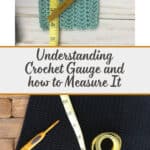Understanding Crochet Gauge and How to Measure It
This post may contain affiliate links, meaning that I may earn a small commission if you make a purchase. See our disclosure policy for more information.
Have you ever crocheted an adorable child’s sweater, hat or other masterpiece only to discover that the finished item is way too small or way too large? Nothing can burst that accomplishment bubble quite like a wonky finished object can. We are going to remedy this predicament today, folks, as we discuss crochet gauge.
Understanding Crochet Gauge and How to Measure It
What is gauge?
Crochet gauge is directly related to how loosely or tightly you crochet when compared to other crocheters. If you crochet very loose, your gauge (and therefore your entire finished work) will be much larger than someone that holds their yarn very tight. As such, crochet gauge correlates directly to the number of stitches in a given area of your work.
Typically 4″ square, the gauge of a pattern (if listed) tells you how many stitches the pattern designer used to get 4″ across and then how many rows it took to obtain 4″ in height.
Why is crochet gauge important?
In some crochet patterns gauge is unimportant. Say a dishcloth, a hair towel, one of these Scentsy car tin holders etc. It doesn’t really matter if my dishcloth is an inch or three too large, a dishcloth is a dishcloth is a dishcloth. Gauge is very important, however, when crocheting something that will be worn or something that needs to end up a specific size.
If a gauge is listed in a pattern, it is wise to complete a gauge swatch. I know, I know… I hate doing them too. A necessary evil in some projects unfortunately.
Wanna save this for later?
How to measure your gauge
Simply crochet until you have at least 4″ wide, then continue crocheting in rows until you get to at least 4″ square. Lay your crocheted piece out – trying not to stretch it – and count how many stitches there are within 4″. Then turn the measuring tape perpendicular and measure how many rows you have within 4″. How does that measure up to the stitch count in the gauge listed on the pattern? Are you close to that magic number or are you way off?

To adjust your gauge to match a pattern…
If a designer has 11 stitches and 18 rows in a 4″ square piece, while I had 16 stitches and 23 rows, I know that I crochet much tighter than the designer. Therefore, I need to adjust my tension (or hook size) to more closely resemble that of the pattern. Do you have too many stitches? Go up a hook size and try again. Do you have too few stitches? Go down a hook size and try again.
More crochet tips before you go!
How to Crochet the Invisible Decrease for Amigurimi Crochet
How to Change Colors in Crochet
How to Create Planned Yarn Color Transitions in Crochet
18 Craft Fair Tips for Beginners: How to Run a Successful Craft Show Booth
Foundation Single Crochet: How to Video + Why You Need to Learn
How to Add a Zipper and Lining to a Crochet Bag










